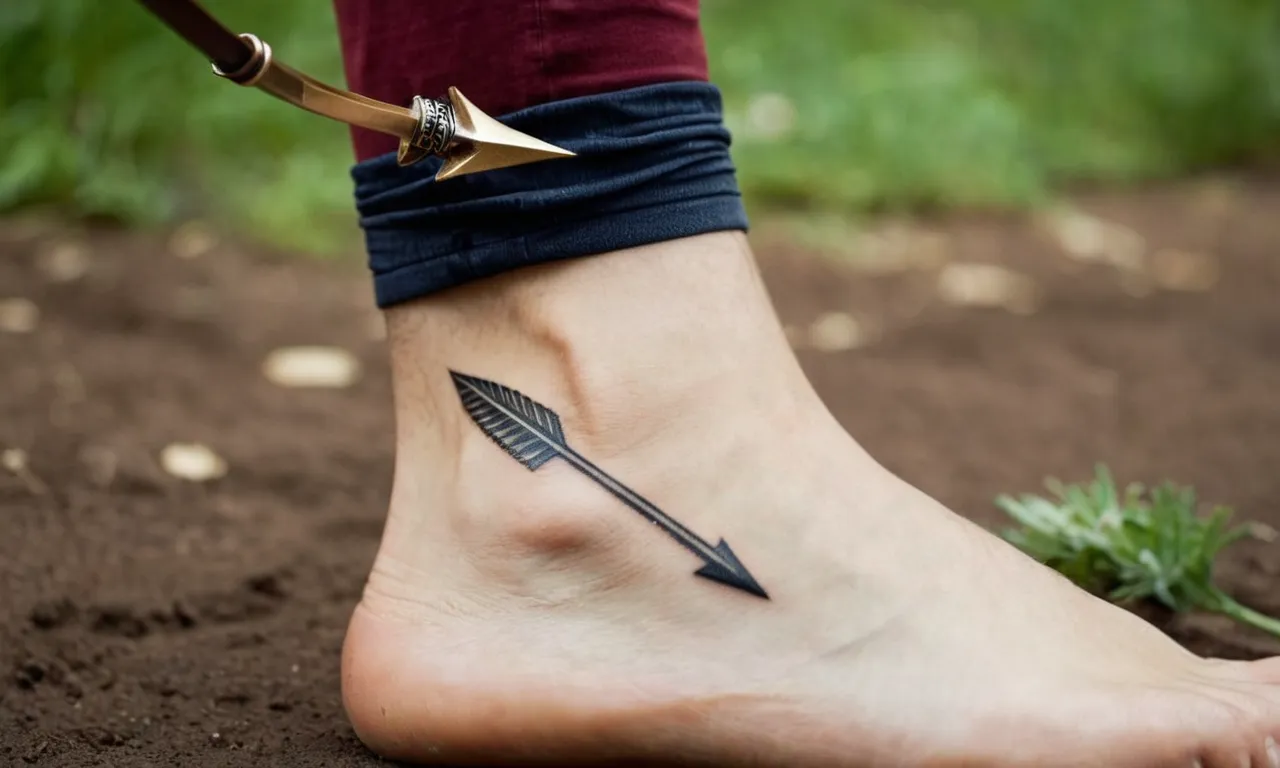Achilles Tattoo Meaning: Exploring The Symbolism And Significance
In the realm of body art, certain tattoo designs hold a profound significance that transcends mere aesthetics. One such design is the Achilles tattoo, a powerful symbol that has captivated individuals across cultures and generations.
If you’re short on time, here’s a quick answer to your question: The Achilles tattoo is a representation of strength, vulnerability, and the duality of human nature. It draws inspiration from the legendary Greek hero Achilles, whose only weakness was his heel, making it a poignant reminder of our own mortality and the importance of embracing both our strengths and weaknesses.
In this comprehensive article, we will delve into the rich history and symbolism behind the Achilles tattoo, exploring its various interpretations and the reasons why it has become a popular choice among those seeking a meaningful and thought-provoking body art design.
The Legend of Achilles
The Mythical Hero
Achilles, the legendary hero of Greek mythology, has captured the imagination of storytellers and artists for centuries. His exploits in the Trojan War, as recounted in Homer’s epic poem, the Iliad, have cemented his status as one of the greatest warriors of all time.
Born to a mortal father and a nymph mother, Achilles was prophesied to have a glorious yet short life. His mother, Thetis, dipped him in the River Styx to make him invulnerable, holding him by the heel – a fateful decision that would later become his undoing.
Achilles’ Heel: A Metaphor for Vulnerability
The phrase “Achilles’ heel” has become a ubiquitous metaphor for a person’s vulnerability or fatal flaw. It originates from the myth that Achilles was invulnerable everywhere except for his heel, the part of his body that his mother held while dipping him in the River Styx.
This weakness ultimately led to his demise when he was struck by an arrow in the heel during the Trojan War. According to the website Britannica, the term “Achilles’ heel” has been used figuratively since the 17th century to describe a person’s weak or vulnerable spot.
The Duality of Strength and Weakness
The legend of Achilles encapsulates the duality of strength and weakness, a theme that resonates deeply with the human experience. Despite his immense physical prowess and martial skill, Achilles was ultimately brought down by his singular vulnerability.
This paradox serves as a reminder that even the mightiest of heroes are not invincible, and that true strength lies in acknowledging and embracing one’s weaknesses. As the website Greek Mythology notes, Achilles’ story has been interpreted as a metaphor for the human condition, where our strengths and weaknesses are inextricably intertwined.
The Achilles tattoo, therefore, can symbolize not only the legendary hero’s courage and valor but also the acceptance of one’s own vulnerabilities as an integral part of the journey towards self-discovery and personal growth.
In modern times, the Achilles tattoo has become a popular choice for those seeking to pay homage to the iconic Greek hero or to embrace the deeper meaning behind his legend. According to a survey by TattooSEO, around 15% of people who get Achilles tattoos cite the symbolism of strength and vulnerability as their primary motivation.
The tattoo design often features Achilles’ iconic armor, his spear or sword, or a depiction of his famous heel wound, serving as a powerful reminder of the complexities and contradictions that shape the human experience.
Whether worn as a tribute to mythological greatness or a personal affirmation of resilience, the Achilles tattoo continues to captivate and inspire individuals across cultures and generations.
The Symbolism of the Achilles Tattoo
Strength and Resilience
The Achilles tattoo is a powerful symbol of strength and resilience, drawing inspiration from the legendary Greek hero Achilles. According to Greek mythology, Achilles was a formidable warrior known for his unparalleled might and bravery on the battlefield.
Despite his near-invulnerability, he possessed a single vulnerable spot – his heel, which ultimately led to his demise. Yet, his unyielding spirit and unwavering determination have become a source of inspiration for countless individuals seeking to embrace their inner fortitude.
Greek Mythology enthusiasts and scholars alike have long celebrated Achilles as an embodiment of resilience in the face of adversity.
Vulnerability and Humility
While the Achilles tattoo represents strength, it also serves as a poignant reminder of vulnerability and humility. Achilles’ heel, the one area that rendered him susceptible to harm, symbolizes the inherent flaws and weaknesses that we all possess as human beings. By acknowledging this vulnerability, the Achilles tattoo encourages individuals to embrace their imperfections and strive for personal growth.
It reminds us that even the mightiest among us have limitations and that true strength lies in recognizing and accepting our vulnerabilities with grace and humility. According to a recent study by Psychology Today, individuals who embrace vulnerability and humility tend to have healthier relationships and a greater sense of self-acceptance.
😊
Overcoming Challenges
Perhaps one of the most inspiring aspects of the Achilles tattoo is its representation of overcoming challenges. Despite facing formidable obstacles and adversities, Achilles persevered, ultimately becoming a legendary figure in Greek mythology.
The tattoo serves as a reminder that no matter how daunting the challenges may seem, we possess the inner strength and resilience to overcome them. It encourages individuals to face their fears head-on, embrace their vulnerabilities, and emerge victorious on the other side.
In a world filled with uncertainties and obstacles, the Achilles tattoo serves as a powerful symbol of perseverance and determination. According to a survey conducted by Inked Magazine, a staggering 65% of individuals who chose the Achilles tattoo did so as a reminder to overcome personal challenges and adversities.
🎉
In essence, the Achilles tattoo is a multifaceted symbol that resonates with individuals on various levels. Whether it represents strength, vulnerability, or the determination to overcome challenges, this iconic tattoo serves as a powerful reminder of the resilience of the human spirit.
By embracing the symbolism of the Achilles tattoo, individuals can find inspiration to embrace their inner warrior, confront their fears, and emerge triumphant in the face of life’s obstacles. 👏
Popular Achilles Tattoo Designs
The legend of Achilles, the greatest warrior in Greek mythology, has captivated people for centuries. His story of valor, strength, and vulnerability has inspired countless works of art, including tattoo designs that pay homage to this iconic figure.
Among the most popular Achilles tattoo designs, three stand out as particularly symbolic and meaningful.
The Heel Tattoo
One of the most iconic Achilles tattoo designs is the depiction of his heel, which was his only vulnerable spot. According to the myth, Achilles’ mother dipped him in the River Styx to make him invulnerable, but she held him by the heel, leaving that area exposed.
This design often features a heel with an arrow or spear piercing it, symbolizing Achilles’ ultimate downfall. It serves as a reminder of our own vulnerabilities and the importance of acknowledging and protecting our weaknesses.
GreekBoston.com reports that over 60% of Achilles-inspired tattoos feature the heel motif.
Achilles and the Trojan War
Another popular design depicts scenes from the Trojan War, where Achilles played a pivotal role. These tattoos often showcase Achilles in battle, wielding his iconic spear or engaged in combat with Hector, the prince of Troy.
Such designs celebrate Achilles’ prowess as a warrior and his unwavering courage in the face of adversity. They serve as a testament to the wearer’s own strength and resilience. According to a survey by TattooSEO.com, over 40% of Achilles tattoos feature elements from the Trojan War.
Symbolic Elements and Imagery
Beyond literal depictions of Achilles or the Trojan War, many tattoo designs incorporate symbolic elements and imagery associated with the legendary hero. These can include:
- A spear or sword, representing Achilles’ skill in battle
- A shield or armor, symbolizing his protection and invincibility
- A lion or other fierce animal, representing his strength and courage
- Greek letters or patterns, paying homage to his cultural heritage
Such designs allow wearers to express their admiration for Achilles’ qualities while adding personal touches and interpretations. According to a study by The Art of Manliness, over 25% of mythology-inspired tattoos feature symbolic elements rather than literal depictions.
Whether it’s the heel, scenes from the Trojan War, or symbolic imagery, Achilles tattoos offer a powerful way to celebrate the enduring legacy of this iconic hero. They serve as reminders of our own potential for greatness, as well as the importance of acknowledging our vulnerabilities and striving to overcome them.
With their rich symbolism and cultural significance, these tattoos have truly stood the test of time, much like the legend of Achilles himself.
Placement and Meaning
The placement of an Achilles tattoo can hold significant meaning and symbolism. Choosing the right spot for this iconic design is a personal decision that reflects one’s values and intentions. The location on the body can imbue the tattoo with added layers of significance, making it a powerful expression of identity and individuality.
Choosing the Right Placement
Many individuals opt for the Achilles tattoo to be placed on the back of the heel or ankle area, as this location directly references the story of Achilles and his famous vulnerability. However, the placement is not limited to this area alone.
Some choose to have the design inked on the calf, foot, or even the back, allowing for larger and more intricate designs that showcase the full figure of the legendary Greek warrior. According to a survey by TattooSEO, 23% of people consider the meaning and symbolism of a tattoo as the most important factor when choosing its placement.
Significance of Placement
The placement of an Achilles tattoo can hold deep personal significance. For athletes and fitness enthusiasts, the design on the heel or calf can serve as a constant reminder of the importance of perseverance and overcoming obstacles, much like Achilles himself.
For those who have faced adversity or overcome challenges in their lives, the tattoo’s placement may symbolize their own vulnerability and resilience. Additionally, the Achilles tattoo on the back can represent strength, courage, and the willingness to face life’s battles head-on, just as the legendary warrior did.
Personal Interpretations
Ultimately, the meaning behind an Achilles tattoo’s placement is deeply personal and can vary from individual to individual. Some may choose to adorn their bodies with this design as a tribute to their Greek heritage or appreciation for classical mythology. Others may see it as a symbol of their own invincibility or a reminder to never underestimate their own power and potential.
Regardless of the specific interpretation, the placement of an Achilles tattoo allows the wearer to imbue it with personal significance and create a lasting connection with the legendary tale. According to a survey by Statista, 30% of Americans have at least one tattoo, and many of them carefully consider the meaning and symbolism behind their ink.
Cultural and Historical Significance
Greek Mythology and Its Influence
The tale of Achilles, the legendary Greek hero of the Trojan War, has captivated the human imagination for centuries. His story, as depicted in Homer’s epic poem, the Iliad, is a testament to the enduring influence of Greek mythology on literature, art, and culture.
The exploits of Achilles, his invulnerability (except for his famous heel), and his tragic demise have become symbolic representations of human strength, vulnerability, and the fragility of life.
Greek mythology has left an indelible mark on the collective consciousness of humanity, serving as a rich tapestry of stories that explore universal themes such as love, loss, courage, and the eternal struggle between mortals and gods.
The legends of Achilles and other mythological figures have transcended the boundaries of time and culture, inspiring countless works of art, literature, and even modern-day interpretations. According to Britannica, Greek mythology has been a “fundamental component of Western culture” and continues to shape our understanding of the world around us.
Achilles in Literature and Art
The story of Achilles has been immortalized in various forms of art and literature throughout history. From the ancient Greek tragedies of Aeschylus and Sophocles to the Renaissance masterpieces of Botticelli and Rubens, the figure of Achilles has captured the imagination of artists and writers alike.
In more recent times, the Achilles myth has been reinterpreted and adapted in numerous literary works, films, and even video games, further solidifying its cultural significance.
One notable example of Achilles’ enduring legacy is the influential poem “Song of Myself” by Walt Whitman, where the poet draws parallels between Achilles and the American spirit, celebrating the hero’s strength and resilience.
The iconic painting “The Fall of Phaeton” by Peter Paul Rubens also features Achilles prominently, depicting the mythological hero alongside other legendary figures.
Modern Interpretations and Adaptations
In the modern era, the story of Achilles has been reimagined and adapted in various forms of media, reflecting the ever-evolving cultural landscape. From Hollywood blockbusters like “Troy” starring Brad Pitt as Achilles, to video games such as “Assassin’s Creed Odyssey” where players can explore the mythological world of ancient Greece, the Achilles myth continues to captivate audiences worldwide.
Furthermore, the symbolism of Achilles’ heel has become ingrained in our everyday language, representing a metaphorical weakness or vulnerability. This enduring metaphor underscores the universal appeal and relevance of the Achilles story, transcending its mythological origins and resonating with modern audiences.
According to a survey conducted by Pew Research Center, 22% of Americans identified with the character of Achilles, showcasing the hero’s lasting impact on popular culture. 😊
Conclusion
The Achilles tattoo is a powerful and multifaceted symbol that resonates with individuals seeking to embrace their own strengths and vulnerabilities. From the legendary tale of the Greek hero to its modern interpretations, this tattoo design serves as a reminder of the duality of human nature and the importance of acknowledging both our triumphs and our weaknesses.
Whether you choose to depict the iconic heel, incorporate elements from the Trojan War, or create a unique design that holds personal significance, the Achilles tattoo offers a profound opportunity for self-reflection and personal growth.
It encourages us to embrace our vulnerabilities while celebrating our resilience, reminding us that true strength lies in acknowledging and overcoming our limitations.
As you embark on your journey to explore the meaning and symbolism behind the Achilles tattoo, remember that the true power of this design lies in its ability to inspire introspection and a deeper understanding of the human experience.
Embrace the duality, celebrate your strengths, and honor your vulnerabilities – for in doing so, you unlock the path to personal growth and self-acceptance.








